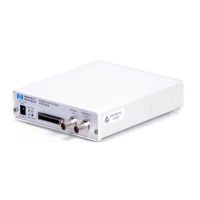2
Emulation for the PowerPC MPC500—At a Glance
Motorola’s embedded PowerPC MPC500 microprocessors provide a
development port (also known as a debug port) that lets tools like the
HP E3456A emulation probe or the HP 16610A emulation module give
you capabilities like:
• Stopping or starting program execution.
• Setting breakpoints in the program.
• Displaying and modifying the contents of microprocessor registers.
• Displaying and modifying the contents of target system memory or I/O.
• Downloading program code to target system memory.
The HP E3456A emulation probe and the HP 16610A emulation
module require that a debug port connector be designed into your
target system (unless you have the HP E2490A analysis probe for
MPC505/509 microprocessors which has a built-in connector for the
emulation probe or emulation module).
Both the HP E3456A emulation probe and the HP 16610A emulation
module come with a target interface module (TIM) that adapts the
emulation probe or emulation module to a debug port connector in the
target system.
The emulation probe or emulation module can be controlled by a
debugger on a host computer or by the Emulation Control Interface on
an HP 16600A/16700A-series logic analysis system.

